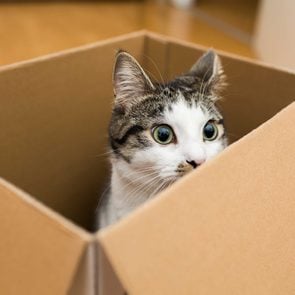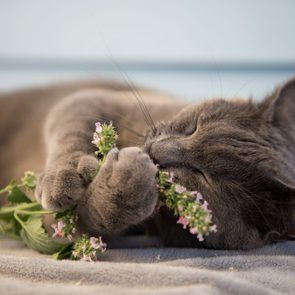Why Do Cats Lick Each Other? The Common Grooming Behavior, Explained
Updated: Nov. 14, 2023

When they’re not sunbathing near a window or sleeping the day away, your cats are at it again: nestled together and licking each other. Sometimes those kitty kisses seem incredibly sweet, and other times, they seem borderline obsessive. It’s definitely one of those strange cat behaviors that can leave you scratching your head. So, why do cats lick each other?
To understand this cat conundrum, we went straight to the experts. Once you know the answer, turn your attention to other pressing questions, such as why cats are scared of cucumbers, why they knock things over and why they hate water.
Why do cats lick each other?
When two or more cats live together, there’s usually at least one that constantly licks the others and engages in a behavior called “allogrooming.” This grooming behavior isn’t strictly limited to cats; it occurs in all “social” animals, including primates. When cats lick one another’s heads, it’s a sign of affection, not to mention bonding and trust. It’s also pretty handy from a grooming perspective: “It’s an area of the body that cats can’t reach to groom themselves, so there could certainly be a functionality to it—helping each other out in hard-to-reach spots,” explains LeeAnna Buis, a feline training and behavior consultant in Seattle.
There’s also another reason cats lick each other that has nothing to do with grooming and everything to do with survival instincts: The cat is “creating a shared scent that’s unique to the group,” says Buis. “Because cats use scent—even before sight—to identify friend from foe, this group scent is incredibly important for recognition.” In short, your cat is hardwired to lick, and this reaches way back to its feline ancestors.
Do cats like to lick each other?
If you hear a gentle purring coming from your cats as they clean each other, don’t be surprised. Experts say it’s how they socialize, and hey, who doesn’t like a good nuzzle every now and then? “It’s a way of showing affection, and it helps strengthen their social bond,” says Jennifer Van de Kieft, an advanced feline training and behavior professional in New York City. And, of course, kisses feel good!
There’s also a maternal instinct involved. “It starts as kittens, when mom holds them down for a minute to get a few quick licks before they run off again,” says Buis. The question of why cats knead, another mysterious behavior, is also related to these reminders of kittenhood and helps to calm your cat.
Do cats lick to show dominance?
If the licking ever seems aggressive, it’s not your imagination. Cats living in the same household may be intent on showing who’s the boss, and that can be demonstrated by cleaning another cat. “In some cases, a dominant cat may groom a cat that is ‘lower’ in social structure (subordinate), perhaps to establish or to reinforce their social dominance,” says Bruce Kornreich, DVM, PhD, a professor at the Cornell University College of Veterinary Medicine and the director of Cornell’s Feline Health Center.
While some cats may appear to be more brazen than others, it doesn’t necessarily mean they are intent on strong-arming—or, in this case, strong-pawing—another kitty. The bottom line: “Cats don’t really have a social hierarchy,” notes Buis.
Why do cats lick each other and then fight?
While cuddles and kisses can be lovely, they’re not always welcome. “If a cat is being groomed and not open to it, or feels it’s too intense, he or she may respond with a hiss or swat to indicate displeasure with the grooming session,” notes Van de Kieft. And since some cats don’t want the scent of another cat on them, they simply don’t want to be groomed—and aren’t shy about letting the other cat know.
Cat anxiety is another reason felines can lick each other continuously. When done to excess, this may cause a fight. If the lickee could talk, they’d basically be saying, “Enough already!”
Now that you know why cats lick each other, find out about other fascinating feline behavior, including why cats wag their tails and why they rub against you.
Sources:
- LeeAnna Buis, feline training and behavior consultant in Seattle
- Jennifer Van de Kieft, advanced feline training and behavior professional in New York City
- Bruce Kornreich, DVM, PhD, professor at Cornell University’s College of Veterinary Medicine and director of Cornell’s Feline Health Center























